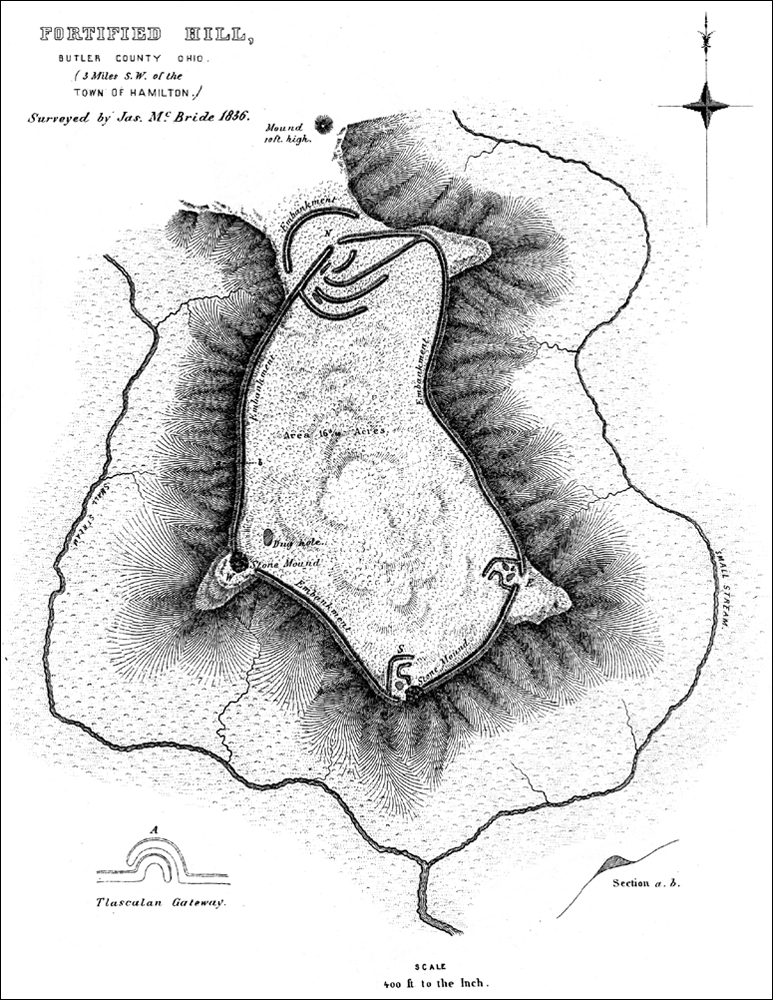Fortified Hill
Location: Near Hamiliton, Ohio
Description: Fortified Hill is a earthworks site near Hamilton, Ohio. Ephraim Squier and Edwin Davis performed a survey of the site in 1847. The site is located on a hill. The earthwork itself consists of an outside ditch followed by an earthwork wall that is eight to ten feet high.
Per Wikipedia:
“The top part of the earthwork is described as enclosing a small circle, one hundred feet in diameter, with two small mounds inside of it. A third mound, which has been ‘truncated’ was just north of the small circle. Both the small mounds had altars found in them after excavation. Ash and sherd were found in the altars. The two men believed it was a fort for defense, with the altars providing spiritual assistance.” [43]
Ancient Monuments of the Mississippi Valley by Squire and Davis states the following:
“THIS fine work is situated in Butler county, Ohio, on the west side of the Great Miami river, three miles below the town of Hamilton. The plan is from a survey by JAMES MCBRIDE, Esq., and the description is made up from his notes. The hill, the summit of which it occupies, is about a half mile distant from the present bed of the river, and is not far from two hundred and fifty feet high, being considerably more elevated than any other in the vicinity. It is surrounded at all points, except a narrow space at the north, by deep ravines, presenting steep and almost inaccessible declivities. The descent towards the north is gradual; and from that direction, the hill is easy of access.”
“In the vicinity of this work, are a number of others occupying the valley; no less than six of large size occur within a distance of six miles down the river.”
“The character of this structure is too obvious to admit of doubt. The position which it occupies is naturally strong, and no mean degree of skill is employed in its artificial defences. Every avenue is strongly guarded. The principal approach, the only point easy of access, or capable of successful assault, is rendered doubly secure. A mound, used perhaps as an alarm post, is placed at about one-fourth of the distance down the ascent; a crescent wall crosses the isthmus, leaving but narrow passages between its ends and the steeps on either hand. Next comes the principal wall of the enclosure. In event of an attack, even though both these defences were carried, there still remains a series of walls so complicated as inevitably to distract and bewilder the assailants, thus giving a marked advantage to the defenders. This advantage may have been much greater than we, in our ignorance of the military system of this ancient people, can understand. But, from the manifest judgment with which their defensive positions were chosen, as well as from the character of their entrenchments, so far as we comprehend them, it is safe to conclude that all parts of this work were the best calculated to secure the objects proposed by the builders, under the modes of attack and defence then practised.” [44]
El Libro de Mormón dice:
Alma 21:152-153 – “152 Pero he aquí, cuán grande fue su desilusión; porque he aquí, los nefitas habían cavado un cerro de tierra a su alrededor, que era tan alto que los lamanitas no podían arrojarles piedras y flechas para que surtieran efecto, ni podían atacarlos, a menos que fuera por su lugar de entrada. 153 Ahora bien, en ese momento, los capitanes en jefe de los lamanitas quedaron sumamente asombrados por la sabiduría de los nefitas al preparar sus lugares de seguridad”.
Alma 21:170-171 – “170 Ahora bien, he aquí, los lamanitas no podían entrar a sus fuertes de seguridad por ningún otro camino que no fuera la entrada, debido a la altura del banco que se había levantado y a la profundidad del zanja que se había cavado alrededor, excepto en la entrada. 171 Y así estaban los nefitas preparados para destruir a todos los que intentaran subir para entrar al fuerte por cualquier otro camino, arrojándoles piedras y flechas”.
(También haga referencia a Alma 21:149-150, Alma 22:1-3, Alma 24:54-55)
